|
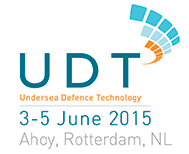
The overall theme for the UDT
2015 conference is 'Autonomy.' This has been specifically chosen to explore the advances in autonomous and semi-autonomous operation for both manned
submarines and unmanned platforms. This reflects one of the key challenges facing the underwater community, in the quest for
cost-effective solutions in the underwater environment.
The
event takes place at: Ahoy Rotterdam, Ahoy-weg 10, 3084 BA ROTTERDAM
CONFERENCE
TOPICS
The UDT conference covers topics in the Following Areas:
* Future Systems Requirements and their Strategic Context
* Platform Design and Integration
* Autonomous Vehicles (sub-surface/surface)
* Energy, Power and Propulsion
* Command, Control and Navigation Systems
* Safety and Life Support Systems
* Sensors and Processing
* Signature Management
* Network Centric Operation and Communications
* Performance Modeling
* Operations, Training and Lifetime Support
* Weapon and Payload Systems
REASONS
FOR ATTENDING
>
60% to find out about the latest technology
>
64% to understand future requirements and gain a broader insight into the market
>
60% to build relationships with exisiting suppliers and network with peers
>
25% to source a new supplier and invest in new products
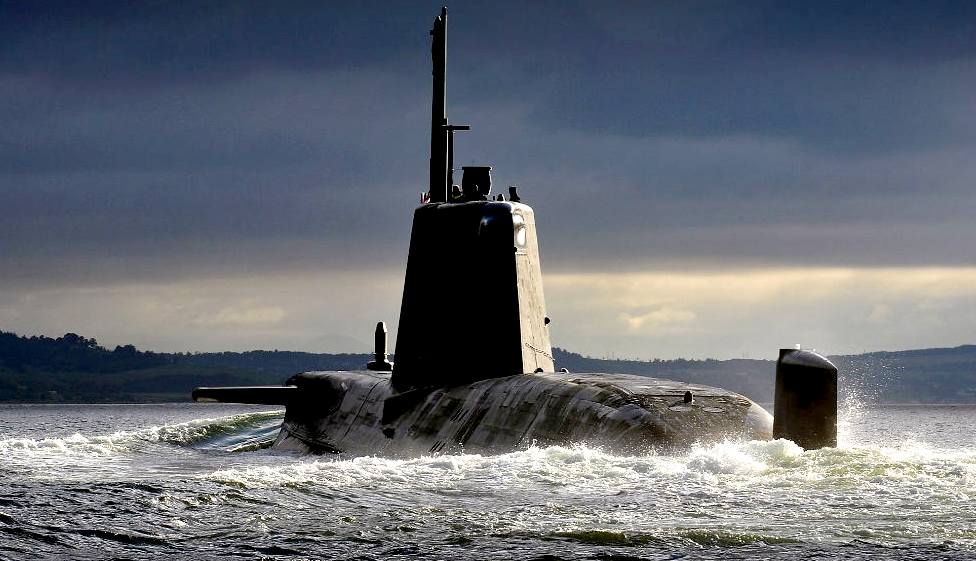
PAPERS
- SPEAKER GUIDELINES
Please follow the guidelines below when submitting your abstract:
You will be required to send your final presentation to Clarion Events by 10 May 2015. Please send these to Emma Banymandhub at
emma.banymandhub@clarionevents.com
Soon after your abstract has been accepted you will be notified of who will be your Session Chair. He/she will be very keen to view your presentation by the deadline, in order to ensure that you have included the right content that is pertinent to your session.
The UDT Organisers and Committee understand that you are likely to have to make changes to your presentation. This is completely acceptable, and new versions can be submitted up to 2 weeks before the event.
A supporting paper is required for all successful UDT abstracts - this must be sent to Emma Banymandhub no later than 10 May 2015.
NB: Authors should be aware that the UDT organisers, and your Session Chair will not accept presentations that includes content that is overtly commercial.
At the UDT Conference
All conference speakers can attend the UDT Conference and Exhibition free of charge for the full three days.
It is essential that you stay within the time allotted to your presentation.
There will be a speakers’ lounge, which will be available throughout the conference, where you can check your presentation and make changes if necessary.
Delegates and speakers to the UDT Conference are entitled to access to a password protected website that contains PDF versions of speaker presentations and/or papers. Please note that presentations delivered at the conference will be published together with papers where they are provided.

ORIGINAL:
The very first autonomous vessel concept could come of age in the next
5-10 years. This large
scale (1:10) development model was a SWATH type twin hull.
At the time of production and showing in 1996 there was no mention of (unmanned) technology
because of patent
law that prohibits publication prior to lodge of application. The idea was
floated with the MOD
in confidence, but there was insufficient interest at the time from the
Admiralty to make it worthwhile investing further in the robotic
concept. The inventor had been working on robots since 1982. His first was
a hexapod
based on, or inspired by insects.
The problem was then that the MOD
did not work with SMEs. The problem exists today to a lesser extent, but
still remains. In the opinion of BMS,
it could constitute negligence, if there is another war where battleships
and submarines
are used in combat, and those vessels are not capable of entering the
arena unmanned, but where the enemy is a fleet comprised of USVs and UUVs.
Submarines will need the support of unmanned surface vessels if they are
to operate successfully in combat conditions.
INNOVATION
SHOWCASE
Supporting the products available on the exhibition floor, exhibitors should use the Innovation Showcase to launch brand new technologies, demonstrate upgrades to their products and show visitors how their products can help end-user operations.
Located on the exhibition floor, the Innovation Showcase offers you the free opportunity to:
>
Present a 30 minute live demonstration of new cutting edge technology
>Engage with a captive audience
>
Increase your UDT exposure before and during the show
How to get involved
Sessions are allocated on a first come first served basis so reserve a slot as soon as your stand is booked. Contact the team to discuss how you can get involved in the Innovation Showcase on the contact details below.
Sponsorship of the Innovation Showcase is also available, ensuring you a speaker slot each day, promotion of your brand on all Innovation Showcase marketing prior to the event, and all on site signage. Contact Rupert Adam
for more information: rupert.adam@clarionevents.com
OPENING
TIMES
UDT runs from Tuesday 3 to Thursday 5 June 2015
Registration Opening Times
Tuesday 3 June 08:30-17:00
Wednesday 4 June 08:30-17:00
Thursday 5 June 08:30-12:00
Conference Opening Times
Tuesday 3 June 10:00-17:30
Wednesday 4 June 09:00-17:30
Thursday 5 June 09:00-15:30
Exhibition Opening Times
Tuesday 3 June 12:00-17:30
Wednesday 4 June 09:30-19:30
Thursday 5 June 09:30-14:30
SPEECH
BY MR PHILIP DUNNE - Minister for Defence Equipment, Support and
Technology
UDT
UNDERSEA DEFENCE TECHNOLOGY CONFERENCE 10 JUNE 2014

From: Ministry of Defence and Philip Dunne MP
Location: Undersea Defence Technologies conference, Liverpool. History: Published 11 June 2014.
Part of: Defence and armed forces.
"In recent months I’ve spoken to industry audiences in Plymouth, Portsmouth and Bristol.
All cities with a rich maritime heritage.
Liverpool is a city of equal importance and historical significance.
Nothing epitomises this more than Cammel Laird.
I have spent the morning at their yard on the other side of the River Mersey.
Seeing the support they are giving both to Royal Navy vessels afloat today and the flagships of the future, building blocks for our new
aircraft
carrier.
The first of which Her Majesty launches next month.
But they have been producing commercial and military vessels in this city since the 1820s.
Vessels that sailed with the World War 2 convoys.
Indeed, much of the ‘Battle of the Atlantic’ against the U-boats was fought and won from Liverpool.
So Liverpool knows better than most the need to be masters of the undersea environment.
That’s why I’m pleased that this city is hosting this international event.
The ultimate deterrent
Your conference today is a timely reminder of the importance of the undersea domain to the United Kingdom.
First, and foremost, it provides us with our ultimate deterrent.
Last week I was off the coast of Florida embarked on USS West Virginia to witness a test firing of 2 Trident 2 D5 missiles.
This successful test demonstrated once again that the Trident remains a credible and reliable deterrent,
Which this government is committed to maintaining.
This means providing ‘continuous at sea deterrence’…
…And preparatory work is well advanced for a like for like replacement.
Only in that way can we maintain the flexibility over when and in what circumstances we would use it…
…which is so critical to an effective deterrent.
And I welcome the clear confirmation in March by the new Shadow Secretary of State for Defence…
…that Her Majesty’s Opposition are also committed to a minimum, credible, independent nuclear deterrent, delivered through CASD.
Earlier this year we announced the investment of more than £300 million to upgrade BAE Systems facilities at Barrow.
Another demonstration of our commitment to replace the Vanguard submarines.
By the time we reach Main Gate in 2016 we will have committed around £3 billion to the “successor” programme.
A sign that we intend to continue building submarines in this country for the foreseeable future.
We continue to invest in the skils and the infrastructure that will allow us to maintain a world-class, battle-winning and cutting-edge capability.
Investment that is already evident in the Astute programme…
…the most technologically advanced submarines that the Royal Navy has ordered and is operating.
Offering a significant step change in capability through world leading sensors, design and weaponry.
The third of class, Artful, was launched last month.
And a contract has been placed for the fourth boat, Audacious, which will safeguard 3,000 skilled jobs at the yard in Barrow.
£1.5 billion has been committed to the remaining 3 boats.
It is all part of a plan to spend around £38 billion on submarines over the next decade.
But our undersea capability stretches further than this.
Mine counter measures
We continue to place a high value on our maritime countermeasures capability.
After nuclear deterrence and carrier strike this is the most influential UK naval strategic capability…
…Indeed without it the former cannot safely leave port.
With the Royal Navy rightly considered as one of the leading organisations in the field.
In Iraq in 2003 the Royal Navy MCM fleet, and the Seafox UOR in particular, were instrumental in the clearing sea lanes to allow humanitarian relief to be delivered.
And they have been on station providing this essential reassurance to international trading fleets ever since.
Iraq might reasonably have been the coming of age for unmanned mine countermeasures.
And Libya was another opportunity for the Royal Navy to demonstrate its unmanned MCM capability, successfully disposing of mines on the approach to Misrata to allow the evacuation of civilians.
Our investment in undersea technology also provides the opportunity for us to exercise our capability in the hydrographic and oceanographic fields in support of tactical navigation and defence needs.
These capabilities are also crucial as we enhance our understanding of the world’s natural resources.
This is increasingly important as tensions over control of the sea bed emerge as a key challenge for the 21st century.
Sea bed oil and gas extraction is well established.
But the prospect of very substantial reserves of copper, manganese, cobalt and rare earth metals suggests at a minimum a need for robust system of sea bed regulation.
It has been suggested that the temptation for nations to go after these resources will lead to some sort of latter day gold-rush.
So proper governance will be vital.
As will the need for the UK to monitor and protect our commercial interests.
Potentially through both traditional and ‘new’ undersea technologies.
So we’re investing in traditional technologies
Despite the financial challenges we face, this government is making the right investments in undersea technology.
In order to protect that investment and maintain the freedom of maneuver of the continuous at sea deterrent we also intend to place contracts for the
Type 26 Global Combat Ship at the end of this year…
This modern, flexible and adaptable warship will have at the core of its design the Anti-Submarine Warfare pedigree of the Type 23 Frigate in terms of noise and sensors.
Also in future technologies
But let’s not forget about investment in future technology.
The conference theme is ‘autonomy’.
We’re investing here too.
In the short-term the main focus of our work is in de-risking platforms for the
Mine Countermeasures and
Hydrography capability.
This capability is currently being delivered by multiple, aging ship clases.
Future capability is likely to employ unmanned off board systems more readily.
This will further reduce risk to our ships and personnel…
…As well as ensuring a more cost effective and flexible capability.
Over the past 2 years the Royal Navy Autonomous Systems Trials Team has been experimenting with innovative systems and developing tactics and doctrine in the countermeasures field.
We’re also developing and maturing novel underwater sensing solutions…
… which we see enabling a step-change in future unmanned technology undersea.
Understanding the potential disruptive nature of these low cost, transformational technologies is essential…
We also believe the UK has a market leading expertise with significant potential for commercial exploitation
But government cannot always go it alone
But at the same time we have to recognise the reality that in developing new platforms and capability we cannot always go it alone.
Given the financial demands and threats we face means squeezing the most out of our resources.
And that can encourage us to work collaboratively.
And while we must ensure that our key national requirements are met, we can work with partners to help get us there.
A good example is the NATO Submarine Rescue System.
A real success story … which has just been exercised at the tri-annual NATO Submarine Escape and Rescue Exercise, Dynamic Monarch 2014, held in Gadynia, Poland.
By jointly operating with France and Norway it offers the UK greater rescue capability than we had before but with costs shared across three allies.
Another example is the work on next generation Mine Counter Measures that we decided earlier this year to take forward jointly with France…
…which will deliver unmanned underwater vehicles capable of finding and neutralising seabed mines.
We have committed to a design stage and empowered OCCAR to place a contract by the end of this year.
We are also exploring alongside this a national programme to ensure freedom of maneuver of our future Mine Countermeasures and Hydrographic capability.
Collaborating with industry too
But our key collaborative partnership is with industry.
And here we are working with our key suppliers to cement our submarine capabilities to manage the planned long-term projects which will span decades ahead.
We are working together collaboratively across the whole Submarine enterprise including the design, build and in-service support functions,
With 3 clear goals:
to improve performance on new and existing submarines
to realise significant savings through the rationalisation of facilities
and to protect our sovereign capability, to design, build and support nuclear submarines into the future
It’s also why I’m such an advocate of the Defence Growth Partnership coming together at Farnborough next month…
…where this government-industry partnership will help the UK defence industry reshape its business model for the next generation of high technology challenges we face…
…To highlight the centres of excellence we have through our supply chains in this country, including in the undersea sector which you are part of…
…and so deliver better value to the MOD and our international defence partners.
Conclusion
So in conclusion…
I believe there is enormous potential for this sector in which you are so actively engaged.
The UK government is playing its part by making the necessary long-term investments.
And we’re working with allies and industry to ensure that the ripples of this investment extend right down the supply chain.
This government is focused on promoting export growth, I see it as my job to help you drive exports too.
This Underwater Defence Technologies event here in Liverpool provides a timely opportunity for you to maximise the part your companies can play as demand rises internationally.
Thank you."
CLARION
CONTACTS
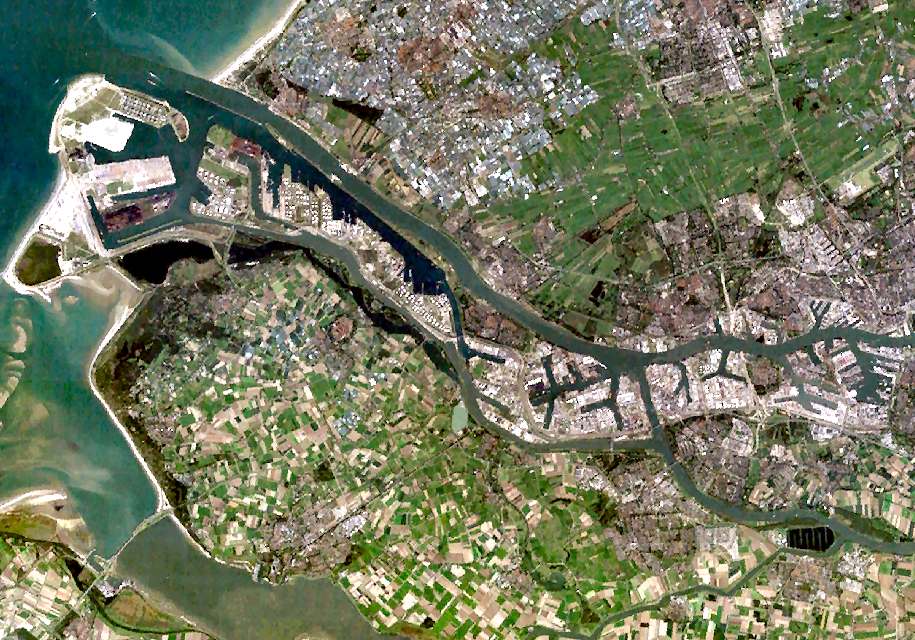
Satellite
picture of Rotterdam Europoort Netherlands 4.25E 51.90N
ROTTERDAM
Rotterdam is the second-largest city in the Netherlands and one of the largest ports in the world. Starting as a dam constructed in 1270 on the Rotte River, Rotterdam has grown into a major international commercial centre. Its strategic location at the Rhine-Meuse-Scheldt delta on the North Sea and at the heart of a massive rail, road, air and inland waterway distribution system extending throughout Europe is the reason that Rotterdam is often called the "Gateway to Europe".
Located in the province of South Holland, Rotterdam is in the west of Netherlands and the south of the Randstad. The population of the city was 619,879 in 2014. The population of the greater Rotterdam area, called "Rotterdam-Rijnmond" or just "Rijnmond", is approximately 1.3 million. The combined urban area of Rotterdam and The Hague with a population of approximately 2.9 million is the 206th largest urban area in the world and the most populous in the Netherlands. Rotterdam is known for its university (Erasmus), cutting-edge architecture, lively cultural life, striking riverside setting and maritime heritage. It is also known for the Rotterdam Blitz.
The largest port in Europe and one of the busiest ports in the world, the port of Rotterdam was the world's busiest port from 1962 to 2004, when it was surpassed by Shanghai. Rotterdam's commercial and strategic importance is based on its location near the mouth of the Nieuwe Maas (New Meuse), a channel in the delta formed by the Rhine and Meuse on the North Sea. These rivers lead directly into the centre of Europe, including the industrial Ruhr region.
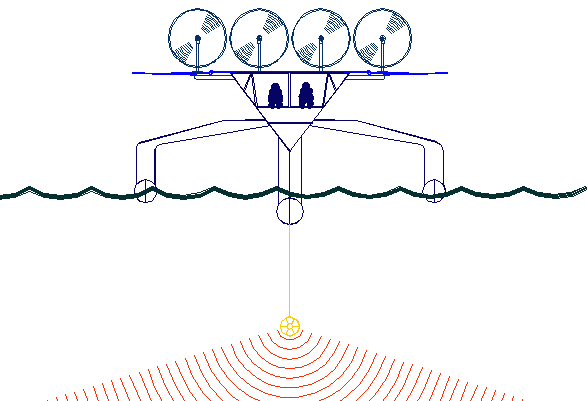
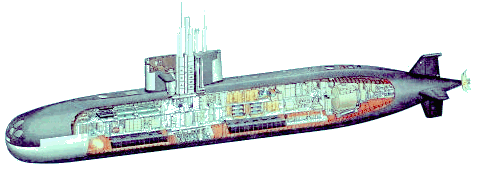
DRONE
SUBS - If the nuclear submarine shown above has a crew on board (most
likely) they are in grave danger, because the submarine hunter-killer (HK)
above is a drone that can either track the submarine and pass information to
a network of marine drones, or, in times of hostilities - sink the submarine
as soon as it is located with torpedoes or depth charges.
A
submarine might get lucky and evade the HK, or even sink it, but once the
position of a submarine is known and transmitted, it will never be safe. The
mission of drone HKs is to find enemy submarines: persistently. The
secondary objective of drone HKs is to sink destroyers and aerial drones
that may be sent out to hunt them.
COST
EFFECTIVENESS - By a process of attrition, drone HKs will decimate an enemy
fleet and financially frustrate any state, even a super power. The maths is
simple. A drone HK cost only a few $million with no loss of life, compared
to a manned destroyer which costs a small fortune and kills hundreds of
crew. The traditional investment in huge floating iron hulls becomes wasted
capital.
UNMANNED
SUBMARINES - The logical conclusion is to eliminate the crew from submarines
and bring in countermeasures. The technology exists to enable this, but
submarines, either manned or unmanned will
need to be supported by friendly surface drones where aerial and marine
drones like that shown could make their situation untenable. Thus, the main
reason for maintaining a fleet of nuclear submarines, namely to be able to
launch a nuclear strike, is neutralized. Contact BMS to find out more.
ROBOT
ADVANTAGE - Another advantage with an unmanned ship is that in the event
of serious mechanical difficulties, the robot
captain will never leave the ship, maintaining communications, steerage,
etc, until relief arrives. For nuclear powered vessels, the advantages
are staggering, where the loss of life is eliminated.
With an older manned
ship breakdown is more likely, but with an
unmanned vessel, early warning of potential failures is built into the
autonomous regime. Typically, there would be several layers of
redundancy in a ship that is designed to operate unmanned. Thus, if a
major failure occurred, the vessel might limp to port unaided. This is
particularly important with unmanned
submarines.
REDUNDANCY
- A manned ship with a crew is unlikely to be able to fix a large
diesel or gas turbine engine at sea. Nuclear powered ships also require docking
for serious breakdowns or contamination. Minor issues will benefit a ship by having a
crew onboard as a quick fix, but at what cost to a nation?
ROTTERDAM
CONTACTS
Rotterdam Partners
Coolsingel 195-197, 3012 AG Rotterdam
P.O. Box 23514, 3001 KM Rotterdam
T: +31 10 - 790 01 40
E: contact@rotterdampartners.nl
Visitor centres
City promotion centre Rotterdam Info Coolsingel
Coolsingel 195-197 (entrance Binnenwegplein)
3012 AG Rotterdam
T: +31 10 - 790 01 85
E: info@rotterdam.info
Opening hours: Mon-Sun 9:30am-6pm
Rotterdam Info Central Station
Stationsplein 45 (entrance Weena)
3013 AK Rotterdam
Open hours: Mon-Sun 9am-5:30pm
Expatdesk Rotterdam
Coolsingel 195-197 (entrance Binnenwegplein)
3012 AG Rotterdam
T: +31 10 790 0190 / +31 10 790 0191
E: expatdesk@rotterdampartners.nl
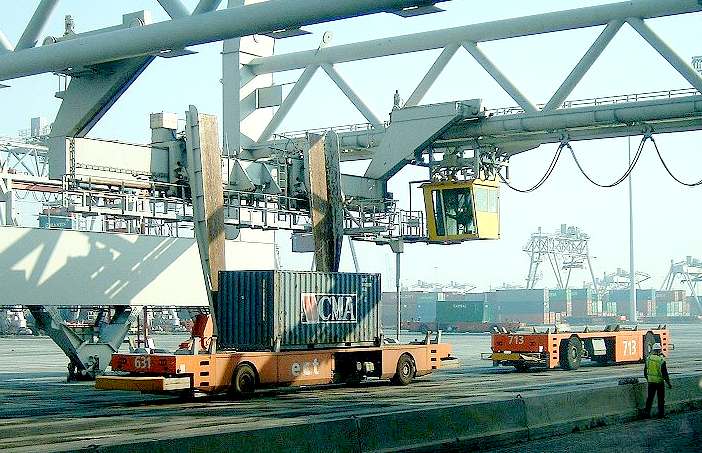
UNMANNED
DOCKS - Much of the container loading and stacking in the port is handled by autonomous robotic cranes and computer controlled chariots. The ECT pioneered the development of terminal automation. At the Delta terminal, the
chariots - or automated guided vehicles (AGV) - are unmanned and each carry one container. The chariots navigate their own way around the terminal with the help of a magnetic grid built into the terminal tarmac. Once a container is loaded onto an AGV, it is identified by infra-red "eyes" and delivered to its designated place within the terminal. This terminal is also named "the ghost terminal".
Unmanned Automated Stacking Cranes (ASC) take containers to/from the AGVs and store them in the stacking yard. The newer Euromax terminal implements an evolution of this design that eliminates the use of Straddle Carriers for the land-side operations.
HISTORY
OF SUBMARINES
In
the World Wars U-boats
were efficient fleet weapons used most effectively in an economic warfare role, enforcing a naval blockades against enemy shipping. The primary targets of the U-boat campaigns in both wars were the merchant convoys bringing supplies from
North America and the British Empire to GB and (during
World War II),
the Soviet Union and Allied Countries in the
Mediterranean.
The
advent of the nuclear submarine brought about a major change in submarine
warfare. Modern undersea boats are faster, dive deeper and have much
longer endurance. Their new size means they've become missile launching
platforms.
Submarines
were the only naval units capable of evading conventional intelligence
capabilities (space satellites, airplanes etc.) that a fight between
evenly matched modern states could bring to bear on them. The whole point
of development is to create a mis-match in technology, to maintain an
edge. But with the inevitable development on unmanned vessels to
persistently monitor the oceans in wolf packs with the latest detection
equipment, countermeasures to the future countermeasures are needed. Where
ZCCs
equipped with torpedoes might easily sink a whole fleet of submarines, the
solution is to use a fleet of ZCCz to neutralise such advantage.
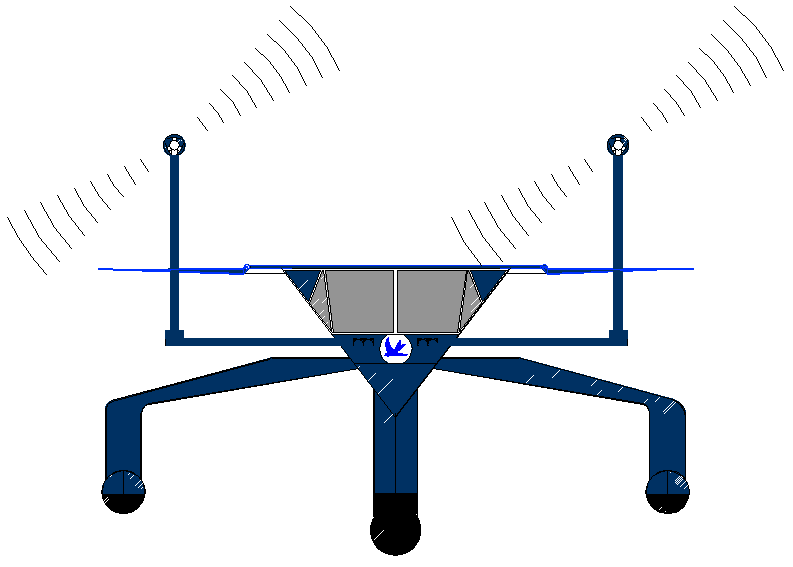
SUBMARINE
SUPPORT & COUNTERMEASURES - The
Bluefish™ platform in a modified form is suitable for adaptation to
submarine fleet support. The Wolverine
ZCC™ may carry 4
x Tomahawks,
2 x 12.75" and 2 x 21"
torpedoes.
This vessel needs no crew and
runs on clean energy from nature. A zoned network of these ships can
police international waters, attack and sink enemy aircraft carriers and submarines
in formation and shoot down aircraft that present a potential threat to
national security. The development of such ships represents an opportunity
for future exports and defence energy reductions.
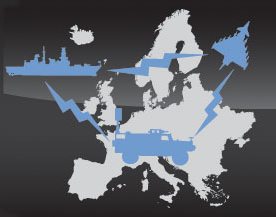
SUBMARINE
INDEX
Alvin
DSV - Woods Hole Oceanographic Institution
Deepsea
Challenger - Mariana Trench, James Cameron 2012
HMS
Astute 1st of Class
HMS
Vanguard- Trident
INS
Sindhurakshak - explosion
& sinking
Littoral
combat vessels
Lusitania
- Torpedo
attack
Nuclear
submarines lost
at sea
Predator
- Covert submarine hunter/killer
Seawolf
- Autonomous wolf pack deployment of Predator mini-subs
Torpedoes
- UUV anti submarine weapons
Trieste
- World record depth - Mariana Trench 1960
U20
- Kapitan Leutnant Walther Schwieger
USS
Bluefish WWI submarine
USS
Bluefish - Nuclear submarine
USS
Flying Fish
USS
Jimmy Carter - Seawolf class fast attack nuclear submarine
USS
Nautilus - 1st nuclear submarine & subsea north pole passage

LINKS
& REFERENCE
Wikipedia
Rotterdam
Rotterdam.information
for visitors
Government
speeches Undersea defence technologies conference
http://en.wikipedia.org/wiki/Rotterdam
http://en.rotterdam.info/visitors/
https://www.gov.uk/government/speeches/undersea-defence-technologies-conference
http://www.udt-global.com/
U-boat-skipper-ruthlessly-torpedoed-British-ship-defied-Hitler-rescue-survivors
http://www.britannica.com/EBchecked/topic/612159/U-boat
Solved-Mystery-missing-WW1-German-submarines-uncovered-explorers-remains-41-U-boats-UK-coast
http://www.historylearningsite.co.uk/u-boats.htm
Uboat
U-boat
archive
http://www.submerged.co.uk/u534.php
https://en.wikipedia.org/wiki/U-boat
http://www.uboatarchive.net/
http://www.uboat.net/
http://www.history.navy.mil/wars/korea/minewar.htm
http://en.wikipedia.org/wiki/Admiralty_Mining_Establishment
http://en.wikipedia.org/wiki/Naval_mine
|









